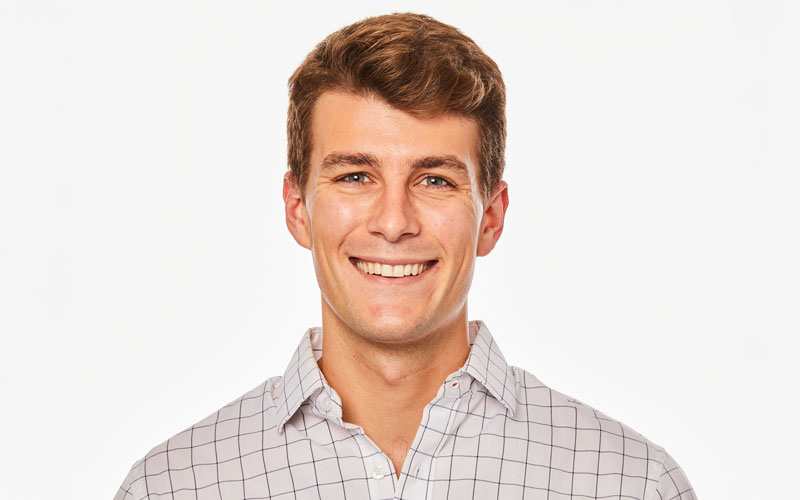Breaking Glass
Lucas Pagni (MaDE '20) reflects on his legacy as one of the first students to participate in the MaDE capstone, how he learned to flourish in ambiguous conditions, and the lessons he carries with him into his professional career.

Lucas Pagni came to Northwestern with plans to continue doing what he loved most: building things from scratch. What he didn't know was that his passion for making would result in him being in the first cohort of the Manufacturing and Design Engineering (MaDE) senior capstone, where he not only created a patentable product, but also helped to define the curriculum and set a gold standard for future capstone students.
Now working for OXO at Helen of Troy, Pagni applies lessons from his MaDE days when he works in new and ambiguous conditions and focuses on human-centered design and empathy.
Breaking through
From the beginning, Pagni (MaDE ’20) was enthralled by the MaDE curriculum and its emphasis on hands-on learning. Rather than sitting through traditional lectures, Pagni immersed himself in interactive coursework that demanded creativity, critical thinking, and empathy.
“I learned design is about truly caring about what you create and how it's used. There's an empathy and thoughtfulness that was instilled in me,” Pagni said. “Segal really gave that structure and put empathy at the core of the problem-solving structure.”
He further applied that philosophy with Professor David Gatchell in the MaDE capstone, a year-long sequence where Pagni and a team were tasked to identify a problem and create a feasible solution for the issue. Pagni was in the first cohort to participate in the MaDE capstone, which was still being shaped.
“I learned how to thrive under ambiguity,” Pagni said. “It often felt like we were ‘building the plane as we flew it,’ but it was a huge learning experience because we got so much ownership over the direction of the project. There wasn't a template for most of the things that we were expected to complete, and I learned so much more by having to build everything from scratch.”
After an extensive interviewing and brainstorming process, Pagni and his team zeroed in on an everyday but surprisingly overlooked problem: cleaning up broken glass.
“People feel uncomfortable cleaning glass or might be worried they're going to step on glass later; there's no best practice for cleaning up broken glass,” Pagni said. “With this problem, we felt we could address the design tenets the class wanted us to, but we also felt it was a problem that needed to be solved.”
The team went all in, interviewing users, testing products already on the market, and generating ideas. The students constructed a five-by-five-foot testing space in the sub-basement of the Ford Motor Company Engineering Design Center with interchangeable floorings — like shag rug, tile, and linoleum — where they shattered and swept up dozens of wine glasses to familiarize themselves with the process.
The team’s solution? A dustpan attachment for a vacuum with a light, which would allow users to sweep up big pieces of glass while illuminating smaller pieces to vacuum.
The team’s work didn’t end there. The group created digital models of their device, communicated with injection molding companies to quote manufacturing prices for plastic parts, and procured a provisional patent. The students' idea was validated when, a year later, Dyson coincidentally released a vacuum cleaner equipped with a light in the same place their team had placed one.
Pagni's commitment to the project despite its newness impressed Gatchell so much that he created a new capstone award, the Breaking Glass Team Award, to recognize future teams who meet the bar that Pagni’s team established.
“The Breaking Glass Award is the highest standard to reach for capstone students. It’s given out in years where teams demonstrate a level of excellence in teamwork, project management, leadership, effort, and application of knowledge and skills learned throughout their time in the MaDE program,” said Gatchell, the director of the MaDE program.
Applying MaDE lessons
After graduating from Northwestern, Pagni got a job as a systems engineer at Boeing and then worked at a vertical farming startup as a mechanical design engineer. He felt aligned with the company's mission to bring fresh produce closer to the consumer at a lower cost using their own proprietary tech.
In this role, he “wore many hats,” working with production equipment, making and testing prototypes, and quoting new equipment. Despite the breadth of his role, Pagni always kept in mind the lessons he learned at Segal.
“When I worked at the startup, I found the human-centered design approach to be really valuable,” Pagni said. “I considered how the user would use what I was working on. Sometimes that meant a physical product, but sometimes it was a process. I talked to people, did research, and tested.”
When the Silicon Valley Bank, which funded countless startups across the globe, collapsed in 2023, the startup struggled to secure funding and shuttered its doors. Looking for a less volatile job, Pagni applied to a company he had long admired: OXO.
"OXO is a company that is used as an example in product design classes. I applied for an engineering role and didn’t get it, but I applied for a different job and got it,” Pagni said. “It was a company I had been thinking about working at for a long time because they do such impressive work.”
Now on OXO’s operations team, Pagni focuses on maintaining existing products and communicating with factories to improve efficiency and brand growth.
For current Segal students looking to start their professional careers, he offers up a piece of hard-earned wisdom.
“Your career can go whatever way you want it to. Starting off can feel difficult, but you can pivot,” he said. “The skills you learn at Segal — problem solving, project management, the human-centered framework — are applicable to so much. Segal opened a lot of doors and provided me with resources to work on what I'm passionate about.”
